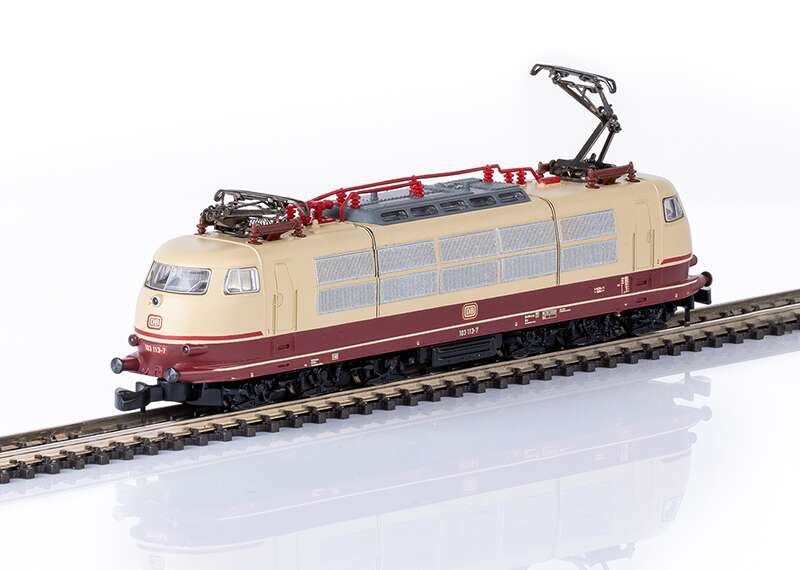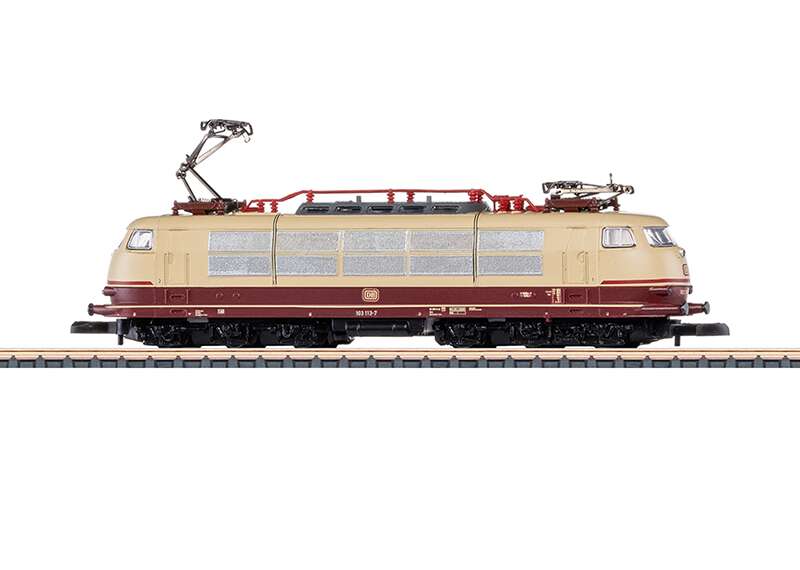Showpiece in the TEE Paint Scheme
It was once the absolute showpiece of the German Federal Railroad. Beautiful in shape, elegant, dynamic, fast, and equipped with pioneering technology. We are talking about the legendary class 103. The prototypes already caused a flurry of excitement as soon as they moved almost majestically on the track. They had their first heyday pulling the TEE trains that offered 1st class, dignified plush, and high quality gastronomy in the dining car. Later in the period of the EuroCity and InterCity trains they were usually spinning along, ubiquitously at a top speed of 200 km/h / 125 mph. It was no wonder in view of 149 units built that it remained hidden from no railroad passengers. Many units then vanished without a trace. Very few remained preserved to the present to remind people of the once glorious class. Among them is road number 103 113. It too was already retired but returned to regular scheduled service. This even happened twice. Since 2017 it is now retired and only now and then is it underway with special trains such as in 2019 when it was a guest in Göppingen. Visually, it attracts attention because its frame is not painted dark gray but rather crimson which fits well with the beige color tone. Finally, something more beautiful: Road number 103 113 part of the roster for the DB Museum in Nürnberg, branch location Koblenz-Lützel, will continue to cause admiring glances. For in the fall of 2020, it was given an overhaul and fresh paint. Even the buffer cladding was put back on the locomotive.
Prototype: DB Museum electric locomotive, road number 103 113-7 as it currently looks in Era VI.
Highlights
- Locomotive body done in metal-impregnated plastic.
- Motor with bell-shaped armature.
- Engine room skylights include window inserts and warm white LED lighting.
Product description
Model: The model has a locomotive body made of metal-impregnated plastic. The locomotive is finely and extensively painted and lettered. It is equipped with a motor with a bell-shaped armature and warm white LED headlights that change over with the direction of travel. The skylights in the engine room have window inserts and the engine room is lit. Both trucks powered. The locomotive has a concealed switch for the working catenary operation. Length over the buffers 88 mm / 3-7/16".
Find more Märklin explanation videos on our YouTube Channel
Spare parts for our articles can be found here in our spare parts search.
Prototype information
The Class 103.1 At the start of the Sixties, the DB decided to expand the growing passenger train service with the development of a powerful locomotive. At the end of 1962, four test locomotives of the new class E 03 were ordered from Henschel (mechanical equipment) and Siemens-Schuckert (electrical equipment). These units were finished in time for the International Transportation Exhibition in 1965 in Munich. Starting in 1969 regular production of the class 103 was done for the InterCity service (IC 71) planned to begin in 1971, but with new specifications. The effective load for TEE and IC trains with speeds of 200 km/h / 125 mph increased from 300 to 480 metric tons, and 800 metric ton D-Zug express trains had to be able to run at 160 km/h / 100 mph. The 145 regular production locomotives – now designated as the class 103.1 – had a basic design that followed that of the prototypes with a bridge frame, locomotive body consisting of five segments, and three-axle trucks. The same end shape was taken from the pre-production locomotives. The most striking thing externally was the doubling of the ventilation openings by a second five-part row of vent grills in the lower half of the side walls. This was caused by a larger air intake due to the greater performance of the locomotive. With a main transformer adjusted for maximum performance (continuous tractive effort output of 6,250 kilovolt amps) and type WBM 368/17f lightweight traction motors with a continuous rating of 1,240 kilowatts the result was a full increase in performance of 25.3% compared to the prototypes – an impressive 7,440 kilowatts or 10,116 horsepower. The last thirty units (road numbers 103 216-245) were equipped with a frame lengthened by 700 mm / 27-1/2" with larger cabs in order to realize the increase in size of the cramped cabs requested urgently by locomotive engineers. In addition, a more powerful air conditioning unit that could control the supply of warm or cool fresh air independent of the outside temperature contributed to the well-being of the engineers. After being delivered in the years 1970 to 1974 the class 103.1 units immediately took over the new IC trains as well as the prestigious TEE trains that had now been partially integrated into the new IC network. The regular production locomotives ran in regular service until December of 2002, over thirty years of use in heavy, high-quality passenger train service running at the highest levels of performance. Several units remained on the roster for reserve and special service. Two units (road numbers 103 113 and 245) are still kept operational at the Munich maintenance facility by the DB Inc. for long distance service and they get a workout regularly.
- Forside
- Trix
- Roco
- Fleischmann
- Lux Modellbau
- Brawa
- Viessmann
- Lenz Digital
- Uhlenbrock
- Byggesett
- Kibri
- Auhagen
- Vollmer
- Faller
- Heljan, SALG!
- Pola, SALG!
- Figurer
- Preiser
- Heki
- Hobbyverktøy
- Byggematerialer
- Maling & lim
- Byggedeler HO og N
- Kabel og utstyr
- HO vognlast
- Modellbiler, SALG!
- Piko, SALG!!
- Båter, SALG!
- Scalextric SALG!!
- Woodland, SALG!






